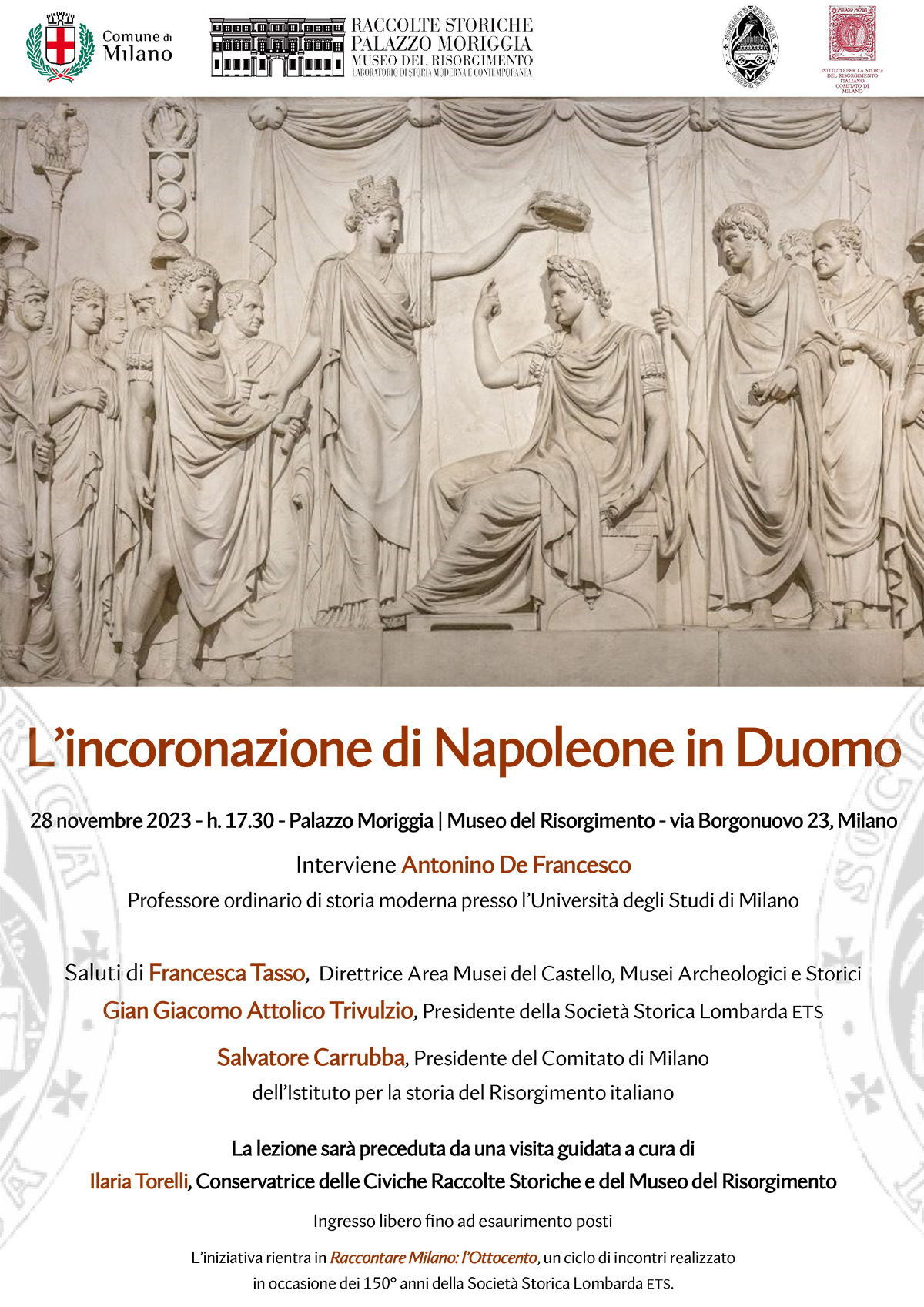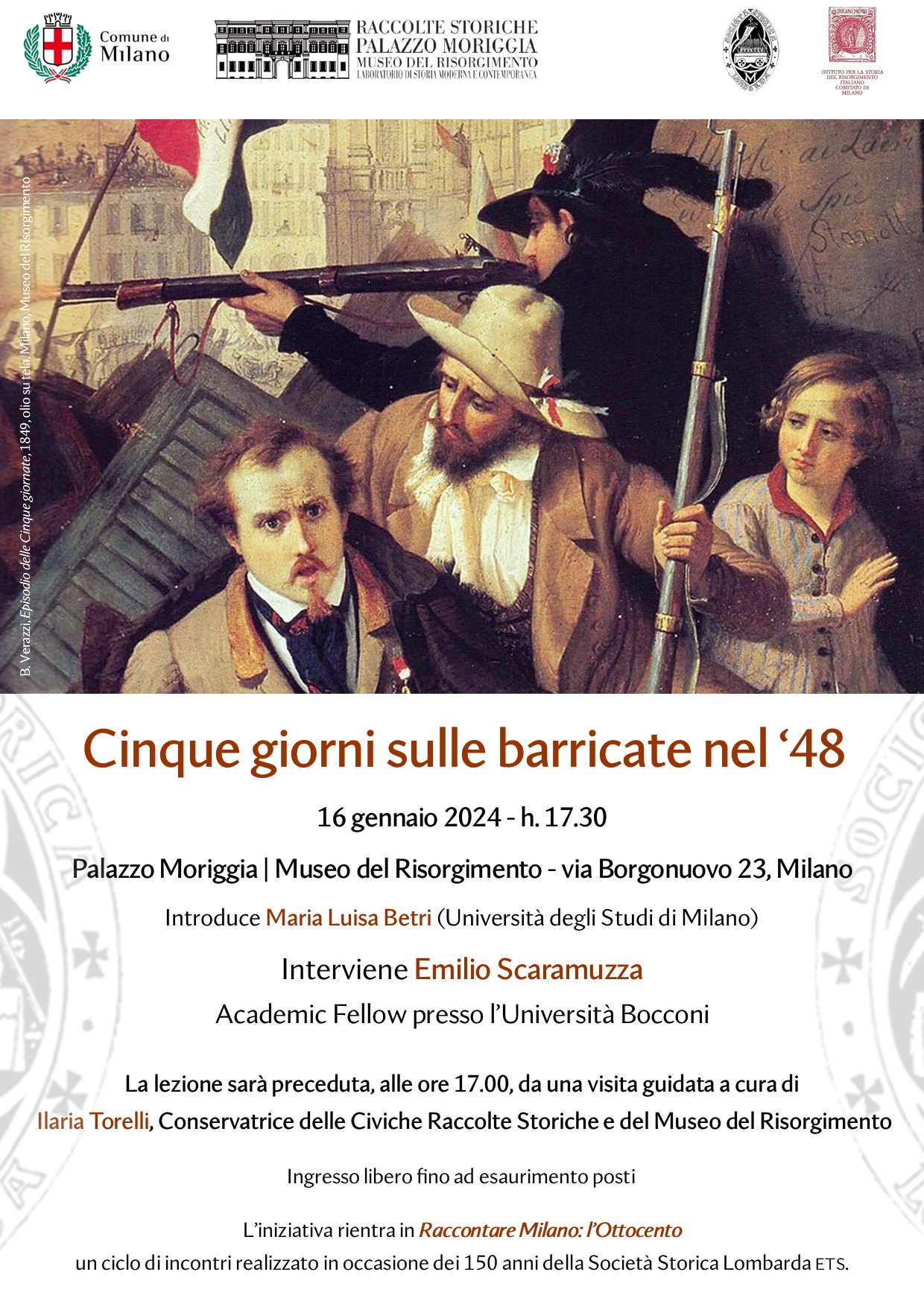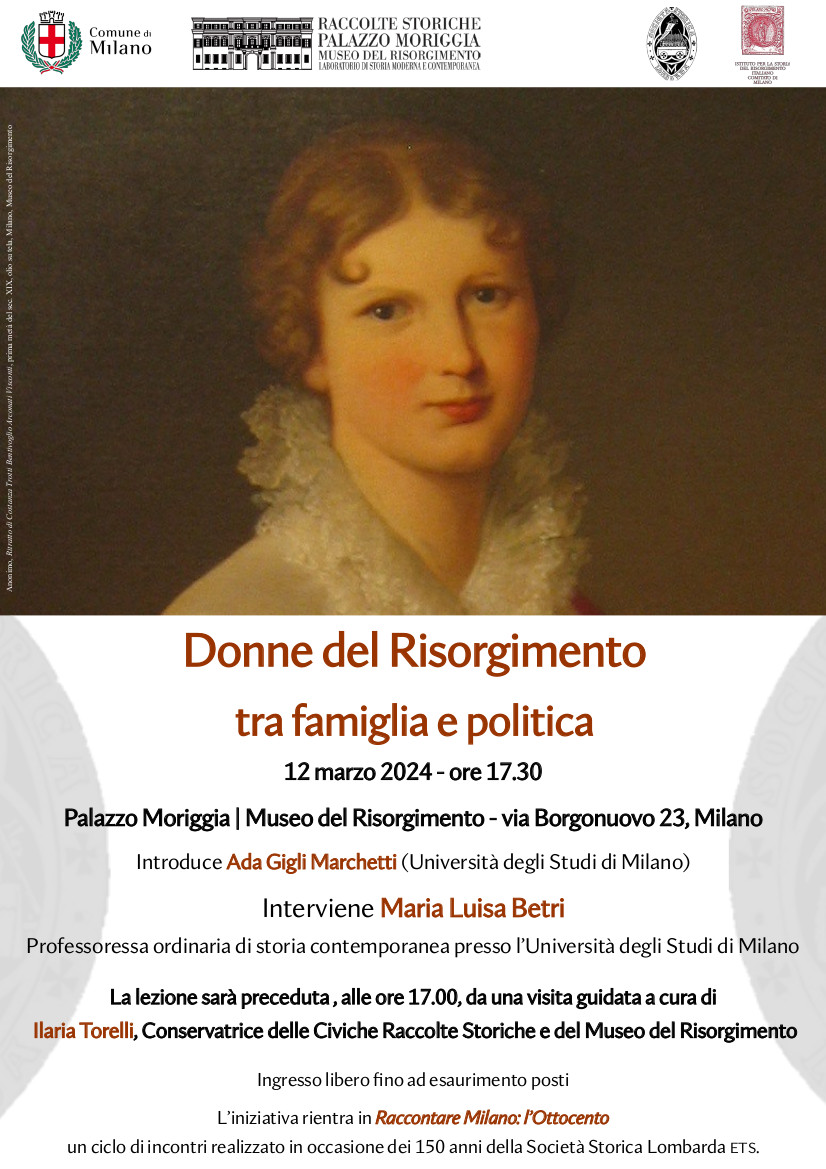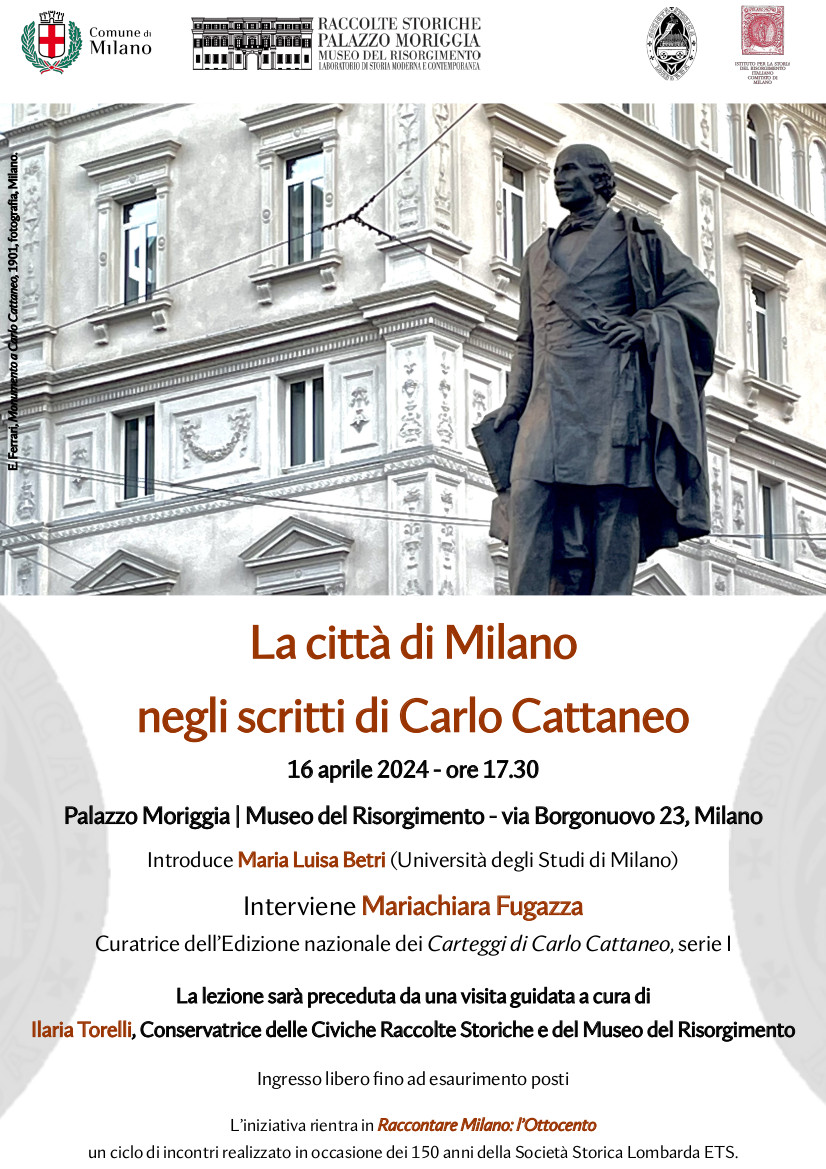Telling Milan - Civic historical collections

Telling Milan: the nineteenth century
"Telling Milan: the nineteenth century" is a series of six meetings on the history of the city. Each meeting will be preceded by a special guided tour of the Museum, curated by the curator and dedicated to the section that will be the subject of the in-depth moment.
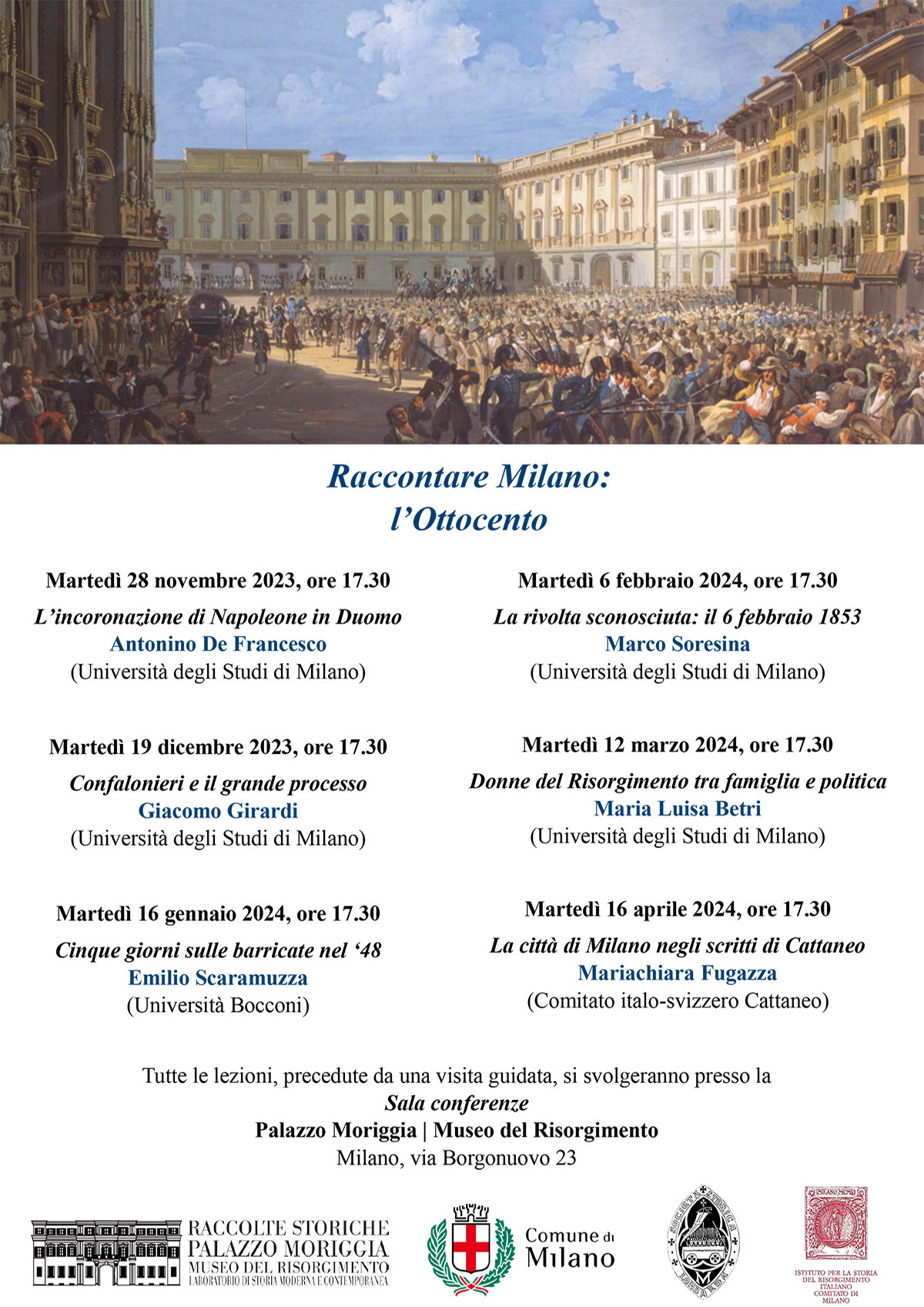
Telling Milan: the nineteenth century
Starting from November 2023 Palazzo Moriggia Civic Historical Collections | The Risorgimento Museum of Milan hosts a series of six meetings, one each month, on the history of the city, entitled "Telling Milan: the nineteenth century". The conferences are conceived and created by the Lombard Historical Society ETS on the occasion of the 150th anniversary of its foundation, in collaboration with the Risorgimento Museum and the Milan Committee of the Institute for the History of the Italian Risorgimento. Each meeting will be preceded by a special guided tour of the Museum, curated by the curator and dedicated to the section that will be the subject of the in-depth moment.
Appointment November 28th
Napoleon's coronation in the Cathedral edited by Antonino De Francesco (University of Milan)
28 November at 17pm guided tour of the museum, 00pm meeting in the conference room
The 26 May 1805 Napoleon, former emperor of the French, wore the iron crown of the ancient kings of Italy. He did it inside the Duomo of Milan, the city that for some years had elected as the capital of a state that extended from Lombardy to Friuli, from Trentino to the Marche and which enjoyed, at least formally, a certain political autonomy. That day was the beginning of the last phase of the revolutionary and Napoleonic period, which would end nine years later, with the abandonment of the city by the viceroy Eugene de Beauharnais and the entry of the Austrians.
A living memory of that day remains in the Risorgimento Museum, where the green velvet cloak decorated with silver, gold and silver-gilt embroidery worn by Napoleon and the coronation memorabilia are preserved.
Guiding the participants through the meaning of that day will be Antonino De Francesco, full professor of modern history at the University of Milan, who is among the most authoritative scholars of the revolutionary and Napoleonic period in Italy. Before the meeting, Patrizia Foglia, representative of the Drawings, Prints Collection and Exhibitions Office of the Civic Historical Collections will lead the public on a special guided tour of the coronation mantle and relics, which were the subject of restoration in 2021.
The evening will be introduced by Francesca Tasso, Director of the Castle Museums Area, Archaeological and Historical Museums of the Municipality of Milan, Giangiacomo Attolico Trivulzio, president of the Lombard Historical Society ETS and by Salvatore Carrubba, president of the Milan Committee of the Institute for the History of Italian Risorgimento.
Appointment December 19th
Confalonieri and the great trial edited by Giacomo Girardi (University of Milan)
19 December 2023, 17pm guided tour of the museum, 00pm meeting in the conference room
Between 1820 and 1821 Europe and South America were shaken by revolutionary movements. The city of Milan played a role of great importance at this juncture, establishing itself as one of the most important centers of the revolution. The intent of the Lombard conspirators, at the center of which stands the figure of Federico Confalonieri, was to rebel against the Austrians, masters of Lombardy (and Veneto) since 1814, and to annex their region to Savoy Piedmont, with the complicity of the regent Carlo Alberto. The end of the first great revolutionary movement of the Risorgimento meant exile, prison, suffering, but also new opportunities.
Inside the Risorgimento Museum, a small section, which recreates the environment of a prison cell, recalls the protagonists of that season, through engravings, paintings and objects.
The participants will be introduced to the theme Giacomo Girardi, research fellow at the University of Milan, who recently edited, together with Silvia Cavicchioli, a volume entitled Challenge at the Vienna congress, which collects a series of essays dedicated precisely to the uprisings of 1820-21.
Before the meeting, Ilaria Torelli, curator of the Museum of the Risorgimento and of the Civic Historical Collections, will lead the public on a special guided tour of the prison room, within the museum itinerary.
Appointment January 16th
Five days on the barricades in '48 edited by Emilio Scaramuzza (Bocconi University)
17 pm guided tour of the museum, 00 pm meeting in the conference room
In 1848 the whole of Europe catches fire: it is the year of wonders, the Spring of the people, the revolutionary moment par excellence of the 1820th century. For a moment, after the failed experiments of 21-1830 and 31-1814, it seems that the order imposed by the Congress of Vienna in 15-XNUMX might finally be questioned. In this context, Italian cities play a decisive role: Palermo, Naples, Venice, Rome, Milan... Impatient with Austrian rule, the Milanese rebel and after five days of fierce fighting the Field Marshal Radetzky he is forced to leave the city with his troops. Thus begins the ephemeral dream of one Lombardy liberated by the presence of an occupying army and united with Piedmont to finally form a great Italian state.
The Risorgimento Museum hosts various rooms dedicated to the Italian 1848-49 period, with particular attention to the founding episode of the Five Days of Milan.
The participants will be introduced to the theme Emilio Scaramuzza, research fellow at the University of Milan, who studies the history of the nineteenth century, in particular the police and Garibaldi's voluntarism in the Risorgimento.
Before the meeting, Ilaria Torelli, curator of the Museum of the Risorgimento and of the Civic Historical Collections, will lead the public on a special guided tour of the Five Days room, within the museum itinerary.
Appointment February 6th
The unknown uprising edited by Marco Soresina (University of Milan)
17 pm guided tour of the museum, 00 pm meeting in the conference room
On 6 February 1853, Milan was the protagonist of a popular revolt, which over the years has been forgotten by the general public and, in part, also by historiography. The motorcycle of 1853 he was known to the Milanese by the nickname "barabba", a dialect term to indicate idlers. The real protagonist of that day was the common people, who organized a revolt, without the help of the bourgeoisie and patriciate, which lasted only a few hours, on the first Sunday of the Ambrosian carnival, against the Austrians present in the city. The motion was inspired by Joseph Mazzini, but operated locally by Olona Committee: although his failure was complete, his memory was important in completing a clear patriotic message towards the common people.
Inside the Risorgimento Museum there is an interesting section reserved for the conspiratorial world: the very famous conspirator by Appiani Jr., but also the desk, the portrait and the death mask of Giuseppe Mazzini, as well as objects and books relating to Young Italy.
The participants will be introduced to the theme Marco Soresina, full professor at the University of Milan, who published the most updated study dedicated to the motion of 6 February 1853.
Before the meeting, Ilaria Torelli, curator of the Museum of the Risorgimento and of the Civic Historical Collections, will lead the public on a special guided tour of the Restoration room.
Appointment March 12th
Women of the Risorgimento between family and politics edited by Maria Luisa Betri (University of Milan)
17 pm guided tour of the museum, 00 pm meeting in the conference room
What was the role of the women during the Risorgimento? Historians have long wondered about the figure of women in the past and 19th century scholars, in particular, have dedicated and are dedicating particular attention to gender issues and relations between the sexes. Traditionally, the role of women has been understood as that of daughters, wives, mothers and sisters: at the service of the man of reference, good and compassionate, guardians of the domestic hearth and of the traditions of the home. In reality, women were much more and acted on the cultural, social and political life of their time, influencing issues such as citizenship and national belonging, work and welfare, consumption and migration. Illustrious women, how Clara Maffei, Costanza Arconati, Christine Trivulzio, were at the center of cultural salons where the new Risorgimento values were cultivated, but some were also at the forefront of the revolutions, like the Arconati and Trivulzio, or how Anita garibaldi.
The Risorgimento Museum hosts masterpieces dedicated to the role of women in history in various rooms.
The topic will be discussed Maria Luisa Betri, former full professor of contemporary history at the University of Milan, who has dedicated important studies to the female universe and numerous other issues.
Before the meeting, Ilaria Torelli, curator of the Museum of the Risorgimento and of the Civic Historical Collections, will lead the public on a special guided tour inside the Museum.
Appointment April 16th
The city of Milan in Cattaneo's writings edited by Mariachiara Fugazza (Italian-Swiss Committee for the publication of Carlo Cattaneo's works)
17 pm guided tour of the museum, 00 pm meeting in the conference room
Carlo Cattaneo (1801-1869), a leading exponent of nineteenth-century culture, is the author of multiple works relating to Milan. His attention to different aspects of the city and the reality of Lombardy is proven by his writings and by the papers in his archive, preserved in the Civic Historical Collections.
Protagonist in Milan in the 1848s and 1860s of various publishing enterprises, from the magazine "Il Politecnico" to the Notizie naturali e civili su la Lombardia, after his participation in the insurrectional event of XNUMX, Cattaneo began an intense memoir activity. Having moved permanently to the Canton of Ticino, he continued to make his voice heard in his hometown, where he returned periodically to give lectures at the Lombard Institute-Academy of Sciences and Letters and in XNUMX he created a second series of "Il Politecnico" . The coherence and originality of his contributions, his method which in the analysis of the evolution of cities over time places the city-territory relationship at the center, have aroused the interest of important interpreters.
It will be an introduction to the topic Mariachiara Fugazza, PhD in history, editor of the national edition of the Carteggi di Carlo Cattaneo, series I, who has published numerous studies around this figure.
Before the meeting, Ilaria Torelli, curator of the Museum of the Risorgimento and of the Civic Historical Collections, will lead the public on a special guided tour inside the Museum.
WHEN
From November 28th to April 16th
one meeting per month - see full calendar
HOW
free admission while seats last
WHERE
Moriggia Palace
Civic Historical Collections | Museum of the Risorgimento
via Borgonuovo, 23
Milano
